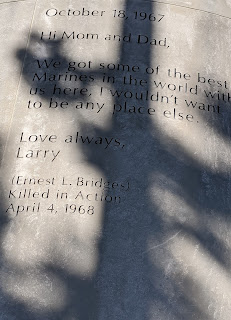After exploring the beautiful beadwork and actually being encouraged to touch some amazing bronze sculptures at Indianapolis' Eiteljorg Museum of American Indians and Western Art, we walked along the canal behind the museum. The Canal Walk, which stretched through the urban White River State Park, was part of the Indiana Central Canal and was dug in the early 1800s to transport farmers' produce to market and merchandise to local shops.
The steam clock outside the Indiana State Museum sounded like it was about to expire and was on its last legs when it got all steamed up on the 5 o'clock hour!
Suspended in the water under the Blackford Street Canal bridge was this unusual sculpture. I read that it was part of a three-part project "that acts as a metaphor for how humans might interact with the environment."
I was glad I looked up and noticed another strange piece of art. I didn't know whether it was a banana or replica dugout canoe that may have been used by the state's early Indigenous people.
On the other side of the canal was Military Park which began its existence in the 1820s as a Military Reservation where the state militia could occasionally train. Beginning in 1852, the Indiana State Fair and then other state fairs were held on the grounds until 1861. A year later, the fun and frivolity at the fairgrounds ceased, and the grounds were used as a military park known as Camp Sullivan.
Across from the Eiteljorg Museum we'd viewed earlier and by the canal was the tremendously moving Medal of Honor Memorial. Created by artists Eric Fulford and Ann Reed, the memorial consisted of 27 curved glass walls that paid tribute to 3,456 Medal of Honor recipients representing 15 different conflicts.
I don't know what these grasses were but I have always loved their soft and fluttery appearance.
On our way back to the car, we noticed The Tent, a steel-painted sculpture created by artist Donald Lipski. The sculpture caught our attention with its 23 different bright colors and nearly 500 panels!
Downtown was the Indiana World War Memorial that was designed as the centerpiece of the adjacent Indiana World War Memorial Plaza. The memorial to the veterans of WW I was begun in 1926 but not completed until 1965 because of funding issues. The mammoth cubical structure was built from ashlar Indiana limestone and had four identical facades.
In the front was a grand staircase.
In Veterans Memorial Plaza across from the memorial, was a black granite obelisk and fountain built in 1923. Near the base of the obelisk were panels placed in 1929 that represented law, science, religion, and education intended to represent the fundamentals of the nation.
Nearby were the flags of the fifty states, which were installed in 1976 for the US Bicentennial. They were replaced with the flags of countries of the Americas during the 1987 Pan American Games.
I can't begin to count all the memorials Steven and I have made a point of seeing all over this and other countries. I readily admit to certainly not remembering many of them either. One that will stay with me, though, was this semi-circular granite memorial that not only listed the names of the Indiana residents who died in the Vietnam War but had inscribed into the granite actual letters written by soldiers to their loved ones back home.
"Most of us are scared to death but somebody has to fight this dirty war" was what 'Fred, the soldier boy,' wrote to his parents in December of 1967, 11 months before he was killed in action.
We drove next to the Scottish Rite Cathedral that was built from 1927-29 and is now a Masonic Lodge and event center. The stunning exterior contributed to its being recognized as a National Historic Landmark. It was unfortunately closed because of Covid-19.
For the last eight months or so, I have become increasingly interested in discovering murals as Steven and I explore America. He's been a rock star unearthing them for me and chauffeuring me around to all sorts of out-of-the-way and hard-to-find places and then waiting patiently while I hop out of the car and take photos. Steven: you're the best - I am so blessed.
On the back of the Indy Public Schools building was this fun mural painted by Robert Wyland.
On the side of a stunning historic building, downtown was this lovely butterfly mural. I've looked and looked online but can't find any information on the building, the mural, or the muralist.
About 1.5 miles from downtown Indy was Fountain Square, the first commercial historic district in the entire state. The square, known as FSQ, was one of six Indianapolis Cultural Districts and was also linked to the Indy Cultural Trail, an urban bike and pedestrian path throughout the city.
While dining at socially distanced picnic tables on the patio of the Upland Brewing Company in the Fountain Square neighborhood, we had a huge and colorful mural to admire!
Flowing glass created the illusion of a waterfall in Water Whispers by Truman Lowe.
Lucas Oil Stadium was home to the hometown Colts football team and the Blue Zone!
Next post: ON the Indianapolis Motor Speedway!
Posted on January 25th, 2021, from Denver less than a week after returning from our third 2020 road trip. I know Steven is happy to be home again after driving more than 14,000 miles since beginning our first road trip last May! Please stay safe, healthy, and connected.












































Thanks to my lovely wife for saying such nice things about me. And I’m (slowly) learning to love murals.
ReplyDeleteAww, hon. Glad I was able to make a convert out of you when discovering murals!
ReplyDelete